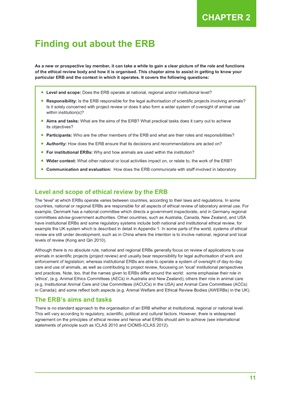
11
Finding out about the ERB
As a new or prospective lay member, it can take a while to gain a clear picture of the role and functions
of the ethical review body and how it is organised. This chapter aims to assist in getting to know your
particular ERB and the context in which it operates. It covers the following questions:
CHAPTER 2
Level and scope: Does the ERB operate at national, regional and/or institutional level?
Responsibility: Is the ERB responsible for the legal authorisation of scientific projects involving animals?
Is it solely concerned with project review or does it also form a wider system of oversight of animal use
within institution(s)?
Aims and tasks: What are the aims of the ERB? What practical tasks does it carry out to achieve
its objectives?
Participants: Who are the other members of the ERB and what are their roles and responsibilities?
Authority: How does the ERB ensure that its decisions and recommendations are acted on?
For institutional ERBs: Why and how animals are used within the institution?
Wider context: What other national or local activities impact on, or relate to, the work of the ERB?
Communication and evaluation: How does the ERB communicate with staff involved in laboratory
Level and scope of ethical review by the ERB
The 'level' at which ERBs operate varies between countries, according to their laws and regulations. In some
countries, national or regional ERBs are responsible for all aspects of ethical review of laboratory animal use. For
example, Denmark has a national committee which directs a government inspectorate, and in Germany regional
committees advise government authorities. Other countries, such as Australia, Canada, New Zealand, and USA
have institutional ERBs and some regulatory systems include both national and institutional ethical review, for
example the UK system which is described in detail in Appendix 1. In some parts of the world, systems of ethical
review are still under development, such as in China where the intention is to involve national, regional and local
levels of review (Kong and Qin 2010).
Although there is no absolute rule, national and regional ERBs generally focus on review of applications to use
animals in scientific projects (project review) and usually bear responsibility for legal authorisation of work and
enforcement of legislation; whereas institutional ERBs are able to operate a system of oversight of day-to-day
care and use of animals, as well as contributing to project review, focussing on "local" institutional perspectives
and practices. Note, too, that the names given to ERBs differ around the world: some emphasise their role in
'ethics', (e.g. Animal Ethics Committees (AECs) in Australia and New Zealand); others their role in animal care
(e.g. Institutional Animal Care and Use Committees (IACUCs) in the USA) and Animal Care Committees (ACCs)
in Canada); and some reflect both aspects (e.g. Animal Welfare and Ethical Review Bodies (AWERBs) in the UK).
The ERB"s aims and tasks
There is no standard approach to the organisation of an ERB whether at institutional, regional or national level.
This will vary according to regulatory, scientific, political and cultural factors. However, there is widespread
agreement on the principles of ethical review and hence what ERBs should aim to achieve (see international
statements of principle such as ICLAS 2010 and CIOMS-ICLAS 2012).